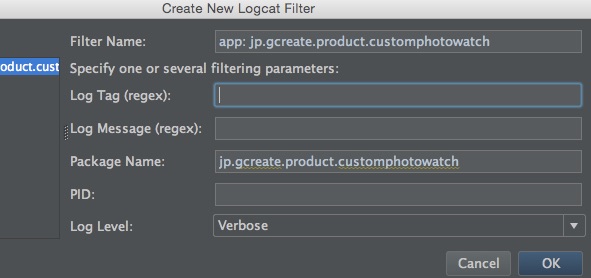

- #Android studio logcat filter only show application for android
- #Android studio logcat filter only show application android
Now connect the device to your computer using a USB cable and you are ready to run ADB commands! List connected devices Find the option USB debugging and enable it. Return to the main screen of the Settings application and go to System -> Advanced -> Developer options. Perform several touches on the Build number until the message “You are now a developer!” appears.

To do that, launch the Settings application and navigate to About Phone, or About emulated device if you’re using an AVD.
#Android studio logcat filter only show application android
Using ADB makes it possible to copy files to/from the device, and is among the most useful of its features, run shell commands in the Android device 📱īefore using ADB, we must enable USB debugging in Developer options in the Android device.
#Android studio logcat filter only show application for android
Table of Contents – Useful ADB Commands For Android TestingĪndroid Debug Bridge, or simply ADB, is a tool included in Android SDK that allows us to send commands from a computer host to an Android device. This saves you time and improves your productivity. This article will show you how you may perform these kinds of actions by a command in a terminal. But if you must manually navigate to the app info screen and press the clear data button before each test, you will reach the end of the day with several valuable minutes, maybe hours, spent doing this repetitive action. This takes less time than fully discharging a battery. The worst scenario would be if you are testing it using an Android Virtual Device (AVD), how would you discharge the battery of an emulator?Īnother required setup with a certain frequency is clearing the application data before launching it. If the battery is full, you’ll need to wait several hours before it is discharged.

Suppose you need to test a feature of your app while the device battery is running low. Some scenarios may require a specific setup that takes a long time to perform ⏳ One way to reduce the log output to a manageable level is to restrict it by using a filter.When testing Android applications, manually or automatically, there are several scenarios to validate. Select or deselect Regex as needed (the setting isn’t remembered). To repeat a search, choose it from the search menu.Press Enter to store the search string in the menu during this session.The logcat output display changes accordingly. Type a character sequence in the search field.Optionally select Regex if you want to use a regular expression search pattern.To search the messages currently displayed in logcat: Assert: Show issues that the developer expects should never happen.Error: Show issues that have caused errors, as well as the message level lower in this list.Warn: Show possible issues that are not yet errors, as well as the message levels lower in this list.Info: Show expected log messages for regular usage, as well as the message levels lower in this list.Debug: Show debug log messages that are useful during development only, as well as the message levels lower in this list.Verbose: Show all log messages (the default).In the Log level menu, select one of the following values: You can display all messages, or just the messages indicating the most severe conditions. You can control how many messages appear in logcat by setting the log level. PID stands for process identifier and TID is thread identifier they can be the same if there’s only one thread. The log message format is: date time PID-TID/package priority/tag: message The priority is one of the following values: Log.i(TAG, "M圜lass.getView() - get item number " + position) Logcat message format Log.d(tag, message)

Log.e(String, String) (error) Log.w(String, String) (warning) Log.i(String, String) (information) Log.d(String, String) (debug) Log.v(String, String) (verbose) import private static final String TAG = "MyActivity". Generally, you should use the following log methods, listed in order from the highest to lowest priority (or, least to most verbose): The Log class allows you to create log messages that appear in logcat.


 0 kommentar(er)
0 kommentar(er)
